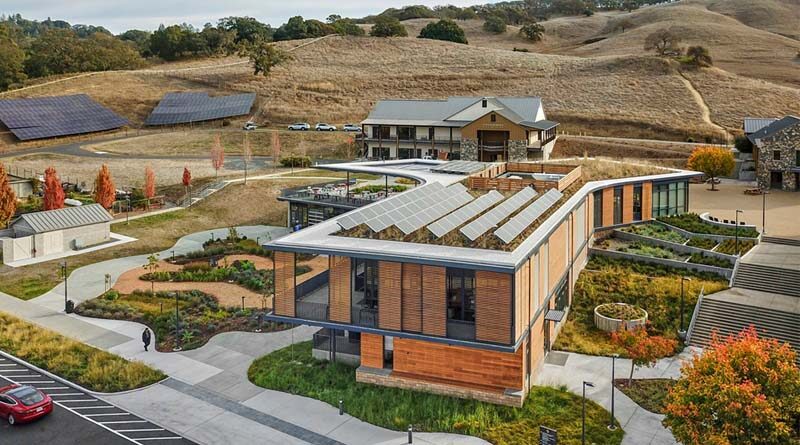California High School Project Achieves LEED Platinum
By SCN Staff
SANTA ROSA, Calif.—Sonoma Academy’s Janet Durgin Guild and Commons was recently awarded LEED Platinum, the U.S. Green Building Council’s highest green building rating. The $17 million project—at the private co-ed college preparatory high school—has also been recognized for its low carbon footprint and material transparency.
Designed by architecture and planning firm, WRNS Studio, the two-story, 19,500-square-foot nature-inspired building houses the school’s student and education center — a hybrid maker space, student dining with an all-electric commercial kitchen, and indoor/outdoor learning facility.
This project showcases how architecture can make nature part of the classroom experience while meeting strict sustainability and energy efficiency objectives. Focused on health and regional considerations, the project is also targeting WELL Education Pilot and LBC Material and Energy Petals— certifications expected later this year.
“Rooted in a culture committed to sustainability, Sonoma Academy’s decision to embrace multiple rigorous benchmarks, demonstrates how they lead by example, working to understand and transform the wider market towards a more sustainable future,” explained WRNS Studio Partner and Sustainability Director Pauline Souza.
“We are excited to achieve this level of certification, and are grateful to our engineering and construction partners who helped us reach this target.”
Sited on a 34-acre campus at the base of Taylor Mountain in Santa Rosa, the Y-shaped, steel-glass-and-wood structure employed several creative design and engineering solutions to lessen its carbon footprint and establish a safe, healthy environment for students to learn.
Leading with biophilia, the building integrates active and passive systems allowing for a ZNE approach that decreases high-energy-component demand by 75+%. To reduce operational energy consumption, the building is 80% naturally lit, wrapped with operable windows and coiling doors for natural ventilation, and has high-performing, low-e glazing. Deep overhangs provide shade and shelter from the elements. Adjustable exterior sunshades and moveable screens tune for user-comfort and curb heat gain.
In more extreme months, heating and cooling is through geoexchange and radiant systems. These efficient methods drive down energy use and reduce water demand compared to traditional HVAC systems. Other energy saving strategies include a photovoltaic rooftop array, a living roof that helps insulate and keeps the PV’s undersides cool, naturally heat-regulating earth block, an all-electric kitchen with induction cooktops which reduces energy consumption while idling, and a waste water management system that accounts for 88% of the building’s total non-potable water demand.
To ensure a space that promotes well-being, a reductive, low-VOC material palette was the foundation for the project. With an emphasis on health and transparency, material selection was guided by LBC Materials Petal, and in compliance with ILFI’s Red List imperative and CDPH.
RHAA Landscape Architects was the landscape and garden architect on this impressive project. The contractor was XL Construction.

